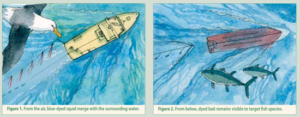Dyed Bait
WHAT IS DYED BAIT?
Dyed bait falls under the wider mitigation measure of stealth gear, which sees the camouflaging of gear and bait to reduce its visibility. Dying bait blue using food colouring and other available dyes has been proposed as a bycatch mitigation strategy for use in pelagic longline fisheries, hoping to reduce the frequency of seabirds interacting with the bait and getting hooked and tangled in the gear. In theory, dyeing bait blue reduces the bait’s visibility from above, altering the colour and reducing the contrast between the bait and the surrounding water. From below the water, the bait remains visible to target fish.

Source: ACAP
CURRENT RESEARCH & USE
With effectiveness at reducing visibility of bait prone to weather and light conditions, dyeing bait is yet to be considered appropriate as a primary bycatch mitigation measure. Instead, the Agreement on the Conservation of Albatrosses and Petrels (ACAP) recommends use of this strategy in combination with other mitigation measures, namely bird-scaring lines and night setting.
Following multiple studies indicating various levels of success, one study highlighted the importance of bait type in reducing bycatch. This study found that when squid were dyed blue this had a stark effect on seabirds (reducing interactions by 68%), compared with blue-dyed fish which were much less effective. More long-term trials are currently underway in Brazil, but similar trials are still required elsewhere to better evaluate the usefulness of dyed bait in reducing seabird bycatch. A trial of blue-dyed bait in the US tuna longline fishery of the central North Pacific found that this measure was not effective for reducing albatross interactions. However, this finding warrants further investigation, as the individual impact of offal discharge and blue-dyed bait could not be separated in some sets in the US trial.
This page was last updated on 20.12.22.
Interested in how this and other measures could mitigate bycatch in your fishery? Get in touch with us to collaborate or take part in a study.
